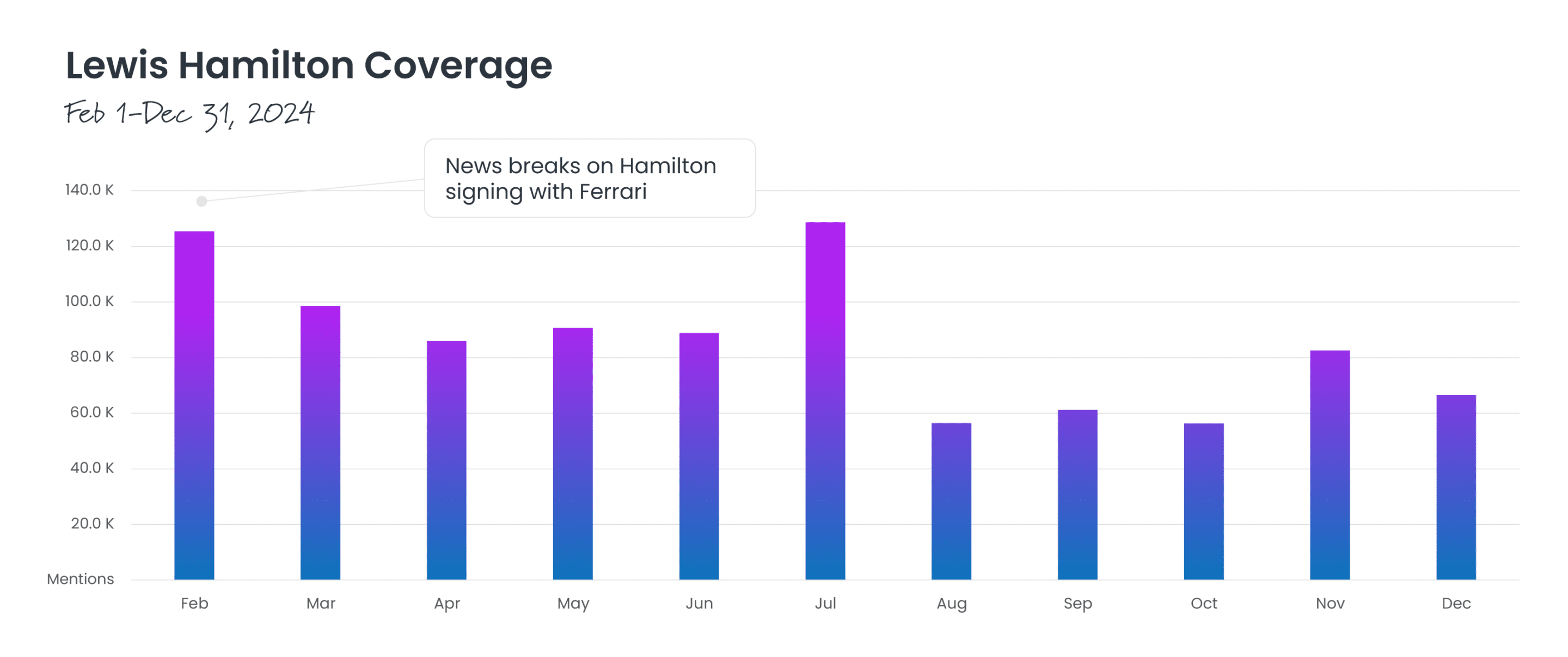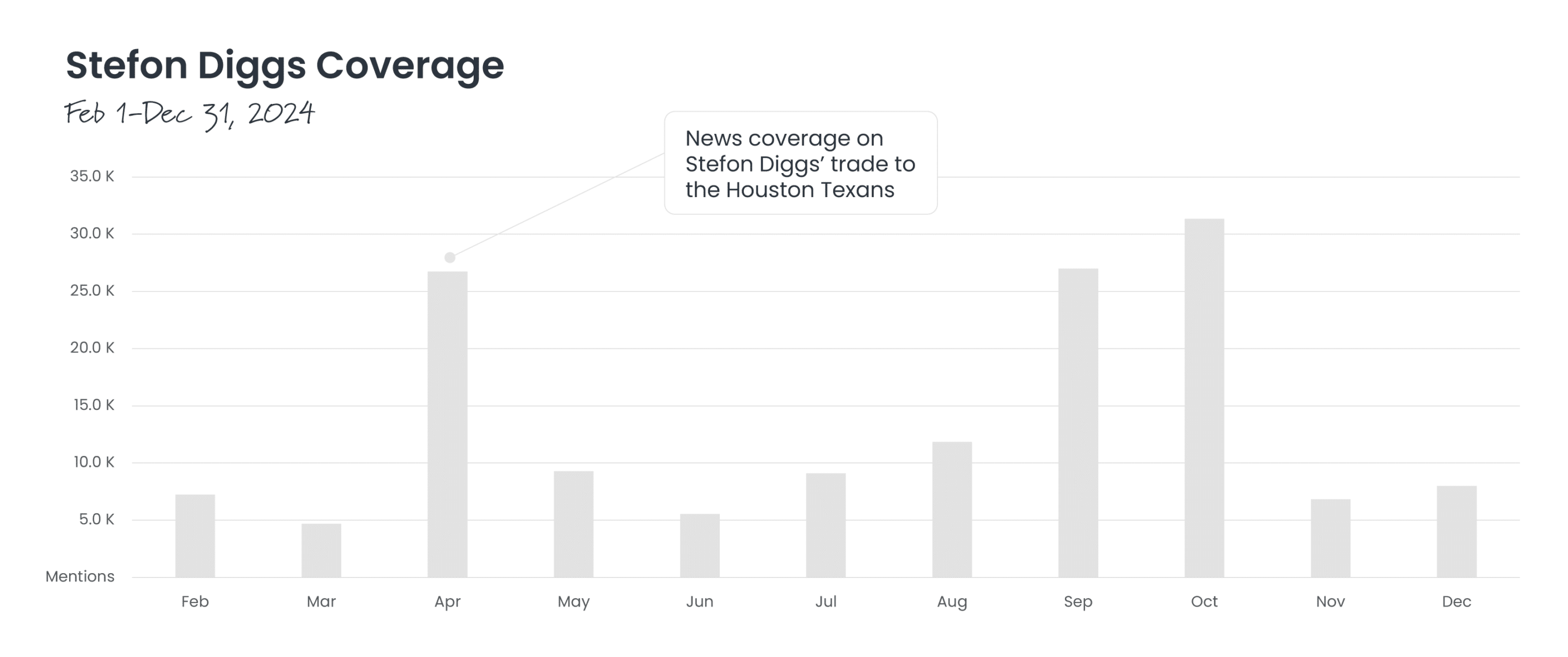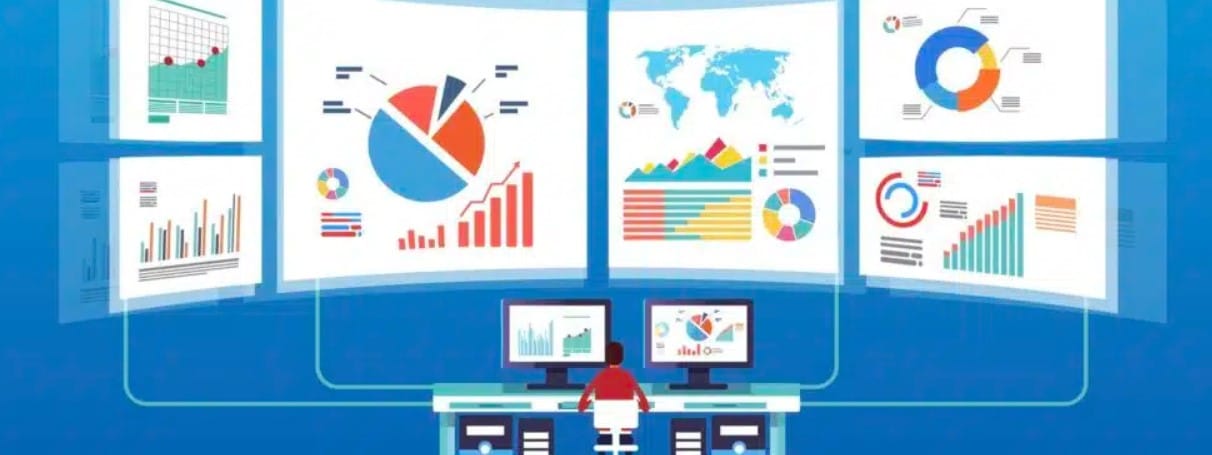Unique events that capture public interest can generate a sudden spike in a brand’s media attention, and even occasionally go viral and dominate media coverage. It’s rare, however, that industry-specific news eclipses its audience and gets widespread attention. In sports, for example, trades involving athletes often generate coverage among fans and insiders, but are common enough that they don’t usually become major news.
However, the recent trade involving two star NBA players—the Dallas Mavericks’ Luka Dončić for the Los Angeles Lakers’ Anthony Davis—was an industry-transcending event that did indeed dominate media coverage. The trade even reached the top of Google Trends during the week of February 2. Given that trades are routine in professional sports, what made this particular deal so influential? While the caliber of the players involved—both among the NBA’s top athletes—undoubtedly contributed to the scope of coverage, it does not fully explain the widespread impact of the news, which extended beyond sports media into the mainstream.
To better understand this phenomenon, the media analysis team at Agility PR Solutions compared this trade to other major sports moves that generated significant media attention this year: Lewis Hamilton’s transition to Ferrari in Formula 1, Julián Álvarez’s move to Atlético Madrid in soccer’s Premier League, and Stefon Diggs’ trade to the Houston Texans in the NFL.
What factors made these trades so newsworthy? Were there common elements that drove their coverage? Which unique aspects of each trade resonated with the media? And what insights can PR professionals gain about turning routine events into trending stories?
Five key factors contributed to the media impact of these trades:
- Surprise Factor – The unexpected nature of these trades heightened intrigue.
- Reactions from Key Figures – Prominent players, executives, and analysts responded strongly.
- Emotional Reactions from the Public – Fans expressed intense excitement or disappointment.
- Future Impact – Each move was framed as a major shift in its respective sport.
- Unique Storylines – Each trade had distinct elements that made it particularly compelling.
The following sections will explore how these factors shaped coverage of each event and what PR professionals can learn from them.
Luka Dončić & Anthony Davis
The blockbuster trade between the Dallas Mavericks and Los Angeles Lakers involving Luka Dončić and Anthony Davis generated a monstrous surge in media coverage during the week of February 2. The trade significantly surpassed the typical volume of coverage both players receive.


Dončić’s move to the Lakers from the Mavericks dominated sports media and beyond, sparking widespread discussion. The trade was unexpected and unfolded rapidly, with many—including players and team staff—unaware of negotiations until they were finalized. It was widely described as shocking, stunning, and unprecedented, with some initially questioning the validity of the reports. Many analysts and fans have since labeled it one of the most surprising transactions in NBA history.
Key figures across the league weighed in on the trade. Dončić himself expressed surprise, stating he had envisioned spending his entire career in Dallas. Mavericks General Manager Nico Harrison defended the decision, emphasizing the team’s focus on defense, believing that “defense wins championships.” LeBron James welcomed Dončić to the Lakers, while players like Kevin Durant called the trade “insane,” noting that it underscored the unpredictable nature of the league. Dončić’s father, Sasa Dončić, criticized the Mavericks for their secrecy and perceived hypocrisy in handling the move.
Fan reactions were polarized. Mavericks fans largely expressed outrage, with some protesting the trade and even requesting refunds on season tickets. Lakers fans, in contrast, were ecstatic about acquiring Dončić. Beyond fan emotions, the trade’s impact on the NBA included broader conversations about player loyalty, team management strategies, and the evolving landscape of roster-building in the NBA. Some analysts questioned whether this deal would set a precedent for franchises becoming more willing to trade their top players as well.
Coverage surrounding Anthony Davis echoed similar sentiments, with descriptions of the trade as a “bombshell” and “blockbuster” move. Many within the NBA community were confused and shocked. Davis himself expressed gratitude to the Lakers and the city of Los Angeles while also acknowledging the disappointment of Mavericks fans. He vowed to earn their support by playing at a high level and instilling confidence in the team’s future. Amid reports that LeBron James was frustrated with Davis, James denied such claims as a factor in the trade. Former Lakers teammate Carmelo Anthony suggested that Davis was unhappy with the move, while Shaquille O’Neal argued that the Mavericks ultimately got the better deal.
A key aspect distinguishing this trade from others is the widespread debate over who benefited most. Many analysts consider the trade one-sided in favor of the Lakers, who acquired Dončić, a young superstar with a long career ahead, while the Mavericks received an aging yet elite player in Davis, whose remaining years in the NBA are uncertain. Speculation about the reasoning behind such an imbalanced deal fueled extensive discussion. Reports indicated that the Mavericks had concerns about Dončić’s conditioning, long-term health, and defensive abilities, while they viewed Davis as a transformative defensive presence. Conversely, the Lakers seemed to be positioning themselves for the post-LeBron era, with Dončić as a potential franchise cornerstone.
In summary, while trades are a routine aspect of professional sports, coverage of the Dončić-Davis deal skyrocketed due to several key factors: the surprise factor, reactions from key figures, intense fan emotions, and the long-term impact on the league. The added layer of debate regarding the fairness of the trade further amplified media attention, becoming the unique storyline that made this news particularly compelling. This case study demonstrates how these five elements can elevate a standard trade into a trending news event. To further explore this phenomenon, we will examine other major athlete transfers across different professional leagues.
Lewis Hamilton
In February 2024, Formula One (F1) driver Lewis Hamilton saw a surge in media coverage following his decision to sign with Ferrari, ending his long-standing tenure with Mercedes. Hamilton had raced with Mercedes since 2013, securing six of his seven world titles with the team. Compared to the other high-profile athlete transfers discussed, his media coverage remained high. This is largely because Hamilton is already one of F1’s most covered figures due to his championship pedigree and enduring popularity. The only period in which he received more coverage was in July, following his first-place finish at the British Grand Prix—his first win since 2021 and a significant victory over Max Verstappen, who had been dominating the sport.

Despite the relatively steady media presence, Hamilton’s move to Ferrari shares key qualities with the Dončić-Davis trade. First, the decision took analysts, fans, and media outlets by surprise—although Hamilton himself was not caught off guard, as he was directly involved in the negotiations. The move was unexpected given Hamilton’s previous statements about wanting to remain with Mercedes for his entire career, as well as his recent two-year contract extension with the team (though this included a release clause allowing him to leave after the 2024 season).
Various F1 personalities weighed in on the move. Hamilton himself described the decision as a pursuit of a new challenge, an opportunity to win his eighth world title, and a childhood dream fulfilled. Ferrari’s team principal, Frédéric Vasseur, as well as his future teammate Charles Leclerc, his current team principal Toto Wolff, and teammate George Russell all provided their perspectives. Fan reactions were also significant—while some believed Hamilton’s most competitive years were behind him, Ferrari supporters largely celebrated his arrival, and Mercedes fans expressed deep emotions over his departure.
The move had major implications for the sport. Ferrari’s stock value rose following the announcement, and speculation grew regarding Carlos Sainz’s future after Hamilton took his seat. Additionally, Hamilton’s departure left a critical vacancy at Mercedes, prompting discussions on who would replace him.
A distinguishing feature of this story compared to other major sports trades is that Hamilton’s move was a personal decision rather than a forced transaction between teams. This shift in agency altered the nature of the media coverage, with significant focus placed on his motivations for the move. Reports suggested that Hamilton viewed Ferrari as offering a better chance at another world championship, though this remains a topic of debate. Coverage explored his current skill level, Ferrari’s competitiveness, and whether this was a strategic or sentimental decision.
In essence, while Hamilton’s transfer shares common media-driving factors with other major athlete moves—such as the element of surprise, reactions from key figures, and significant fan engagement—its uniqueness lies in the emphasis on Hamilton’s own agency and the deeper analysis of his motivations.
Julián Álvarez
In 2024, soccer star Julián Álvarez made headlines with his transfer from Manchester City to Atlético Madrid in a deal valued at up to €95 million. This move significantly boosted Álvarez’s media coverage in July and August.

Similar to Lewis Hamilton’s move, Álvarez’s departure surprised many, particularly given his recent contract extension with Manchester City. However, reports indicated that Álvarez was motivated by a desire for a more prominent role and consistent playing time, as he often found himself overshadowed by Erling Haaland. Álvarez himself acknowledged this sentiment, expressing that he sought greater opportunities on the field.
Several key figures weighed in on the transfer. Manchester City manager Pep Guardiola and Álvarez both addressed his overall satisfaction with the club and his need for more playing time. City captain Kyle Walker acknowledged that Álvarez played “second fiddle” to Haaland and stated that he had “a point to prove now” at Atlético Madrid.
Fan reactions were also notable, with many Manchester City supporters expressing frustration over losing such a talented player. Beyond the immediate impact on both teams, the transfer marked a significant impact on the sport—Álvarez’s sale became the highest in Manchester City’s history, surpassing the £50 million received for Raheem Sterling. Additionally, his arrival at Atlético Madrid was expected to bolster their attacking lineup and strengthen the club’s brand in Latin America, given Álvarez’s Argentinian heritage.
A unique aspect of this transfer was its record-breaking cost. Even within professional soccer, the high price tag generated considerable discussion, with media coverage frequently highlighting the financial magnitude of the deal.
In summary, Álvarez’s move to Atlético Madrid was driven by his ambition for more playing time and a key role, while Atlético saw an opportunity to acquire a high-profile striker. The record-breaking nature of the transfer further amplified media attention, making it one of the most significant player moves of the year.
Stefon Diggs
In April 2024, reports emerged that NFL wide receiver Stefon Diggs would be traded from the Buffalo Bills to the Houston Texans. This news led to a surge in media coverage in April, with additional spikes in September—when Diggs provided insight into his desire for a fresh start in Houston—and in October, following reports that an ACL injury would sideline him for the season.

The trade was widely regarded as surprising, given Diggs’ status as a top-tier NFL player with multiple performance accolades, including consistently surpassing 1,100 receiving yards per season and leading the league in receptions during his first year with Buffalo. As a key contributor to the Bills’ offensive strategy, his departure initially seemed unfavorable for Buffalo. However, reports of tensions between Diggs and the organization provided context for the decision.
Several key figures addressed the trade. Bills quarterback Josh Allen, head coach Sean McDermott, and general manager Brandon Beane acknowledged Diggs’ impact on the team and expressed well wishes. Meanwhile, former NFL players J.J. Watt and Keyshawn Johnson praised the move for the Texans. Adding to the drama, sports analyst Stephen A. Smith claimed Diggs had long wanted out of Buffalo, while The Athletic’s Tim Graham reported a heated exchange between Diggs and Allen. Discussions on the strained relationship between Diggs and the Bills—including insights from NBC Sports’ Mike Florio and Chris Simms—further fueled media coverage.
Fan reactions were mixed. Some Bills supporters believed Buffalo had lost a critical player, while others saw the trade as a necessary move. Social media played a role in the discourse, with Diggs facing criticism from Bills fans and seemingly responding with posts critical of the fan base.
The trade’s impact extended to both teams’ playoff aspirations. For Houston, Diggs was expected to be a key asset for quarterback C.J. Stroud, complementing Nico Collins and Tank Dell in the Texans’ receiving corps. For Buffalo, losing Diggs left a significant gap in their offense.
A unique driver of this story was the reported tension between Diggs and the Bills organization. His frustration was visible on the sidelines, and his absence from mandatory minicamp in the summer had already sparked speculation. Additionally, his brother, Trevon Diggs, publicly encouraged him to leave Buffalo. Reports suggested the Bills were eager to move on from the ongoing drama surrounding Diggs, further fueling media interest in the trade.
Takeaways for PR Professionals
In conclusion, let’s examine the five key factors that drove coverage of these trade deals and how they might be leveraged to gain attention for stories that would otherwise be seen as routine events.
1. Surprise Factor
Stories that surprise tend to generate more interest than those that are expected. Trade news is common in sports just as product releases, firmware updates, and financial results are regular features in other various industries. Yet sudden, unexpected decisions make these trade stories particularly compelling for news organizations, readers, and even mainstream media outside of sports. PR professionals should be mindful of the significant impact that unexpected news can have on coverage.
2. Reactions from Key Figures
Each trade story involved notable personalities, including team managers, players, former players, and well-known sports analysts, who shared their opinions and insights. High-profile spokespeople can significantly boost interest in your brand and increase the visibility of the story you’re trying to promote. Utilizing key figures to share their perspectives is a recommended strategy for driving media attention.
3. Emotional Reactions from the Public
News organizations also consider the public’s emotional response to a story. The trade stories mentioned earlier sparked strong reactions from sports fans, and today, much of this discourse takes place on social media platforms like X, Instagram, Facebook, YouTube, LinkedIn, and Reddit. Even smaller industries and brands can be subject to public discussion on these platforms. PR professionals should engage with the public through these channels to help shape the conversation around their brand.
4. Future Impact
The observable effects of these trades on the teams involved were clear. The high-profile nature of the players and personalities meant their moves would directly impact the success and popularity of both the team they left and the one they joined. In other industries, news stories that have a serious effect on the brands involved would certainly garner attention but may not be as clearly understood as the news stories occurring in sports with its legions of fans, dedicated media, and analysts. PR professionals must ensure the implications of their news are clearly articulated, helping media outlets effectively convey the significance to their audience.
5. Unique Storylines
Finally, it’s important to recognize that the factors above are not the only things that can elevate a story from ordinary to extraordinary. Each trade example had at least one unique aspect that made the story interesting not only to sports enthusiasts but to the mainstream public as well. As a PR professional, think about what unique angle your story might have that will resonate with a broader audience and make it more compelling. Be creative in identifying additional elements that could generate interest.
This research was conducted by Agility PR Solutions’ team of media analysis experts.




